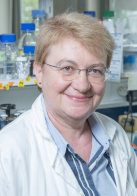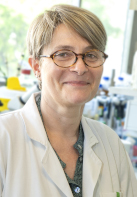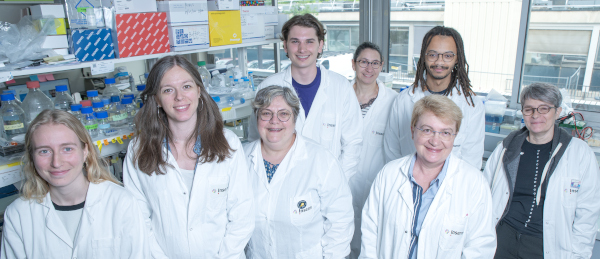
 Co-team leaders : Gisèle Bonne & Valérie Allamand
Co-team leaders : Gisèle Bonne & Valérie Allamand
The team research topics focus on 2 groups of neuromuscular disorders (NMD): myopathies due to defects of the Myomatrix [collagen type VI & ECM-related disorders (Allamand et al. 2011, Skelet Muscle); V Allamand’s group] and of the Myonucleus [Emery-Dreifuss muscular dystrophies (EDMD) & other striated muscle laminopathies (SML) due to mutations of the LMNA gene encoding A-type lamins or genes encoding related nuclear envelope components (Bertrand et al. 2011, Biochem Soc Trans.; Azibani et al. 2014, Semin Cell Dev Biol); Group G Bonne/ AT Bertrand]. These myopathies with prominent contractures or ‘contractural myopathies’ share some clinical features, and may be differentially diagnosed.
These diseases are highly heterogeneous, both clinically and genetically, and no treatment is available yet. Our previous activities have led to the identification of genetic defects, the development of tools (cellular and animal models) and the deciphering of pathophysiological clues for a better comprehension of the molecular bases and the identification of therapeutic targets. Many unresolved issues remain: 1) absence of molecular diagnosis for a subset of patients, 2) precise function of implicated proteins and underlying pathophysiological mechanisms… Several common points (contractile dysfunction, mechanobiology defects, fibrosis…) have been and are still being addressed transversally through pooling of our specific expertise (nuclear envelop, nucleoplasm, extracellular matrix…).
The team’s project revolves around 3 axes:
1) defining the genetic and clinical spectrum and the natural history of these NMDs;
2) investigating the pathophysiological mechanisms of gene mutations that induce these cardiac and/or skeletal muscle affections with the overall goal
3) to identify and test therapeutic avenues for these disorders. This is carried out on biological material from patients (DNA, RNA, cultured cells and biopsies) as well as various animal models we have developed.

Team members
| MyoNucleus related diseases
A Bertrand, CR AIM |
MyoMatrix related diseases V Allamand, DR2 Inserm |
Genetics & NGS
G Bonne, DR1 Inserm |
| L Benarroch, Post-doc M Okubo, Post-doc M Leconte, PhD student |
C Gartioux, IE AIM G Heslaut, Master 1/2 apprentice A Gomis, Master 1/2 apprentice D Kourtzas, IE Inserm |
R Ben You, PH, AIM I Nelson, IR AIM C Gartioux, IE AIM |
| Transversal Activities, G Bonne, DR1 Inserm | |||
|
Clinical expertise D Duboc, PU-PH (5%) |
Data bases & Registries R Ben Yaou, PH attaché AIM (50%) |
Histopathology M Beuvin, IE, AIM |
Filnemus – Research Section G Kpalma, IE, APHP (100%) |
Contacts
Gisèle Bonne (g.bonne@institut-myologie.org)
Valérie Allamand (v.allamand@institut-myologie.org)
Anne Bertrand (a.bertrand@institut-myologie.org)
Projects axes
The specific projects we develop are:
- Clinical and genetic spectrum of Myomatrix and Myonucleus-related diseases: using state of the art medium to high throughput techniques (WES, WGS, RNA-seq) we pursue the identification of new genes and variants for patients orphan of molecular diagnosis in close interaction with the NMD reference center Paris-Nord/Est/Ile de France (B Eymard), the Filnemus network, the ERN Euro-NMD as well as the European consortium Solve RD (H2020 grant 2018-2022). The goal of this axis is ultimately to transfer the knowledge acquired to diagnostic procedures in reference laboratories (e.g., Cardio-& Myogenetic Functional Unit, Hospital Pitié-Salpêtrière; Biochemistry & Molecular Genetics Laboratory, Institut Cochin).
- Natural history of these diseases via national and international patient registries: we further expand the patient recruitment/inclusion in national and international registries and explore in depth the natural history of our disease of interest in order to identify diagnosis and prognosis readouts and biomarkers.
- Deciphering the structure & function of Myomatrix and Myonucleus in health and disease: using the different cellular and animal models available as well as novel models when needed, we aim to decipher further the structure and function of proteins currently known but also of new candidates identified through our investigations, i.e. A-type lamins and related nuclear envelope components, Collagen VI and related extracellular matrix components. In particular, signaling pathways and molecular pathomechanisms are investigated in order to identify relevant and innovative therapeutic targets.
Regarding translation and patient benefit, these different research axes allow us to identify and characterize new genes, phenotypical spectra, related pathomechanisms and therapeutic targets.
Last publications
- Perrin A, Métay C, Savarese M, Ben Yaou R, Demidov G, Nelson I, Solé G, Péréon Y, Bertini ES, Fattori F, D’Amico A, Ricci F, Ginsberg M, Seferian A, Boespflug-Tanguy O, Servais L, Chapon F, Lagrange E, Gaudon K, Bloch A, Ghanem R, Guyant-Maréchal L, Johari M, Van Goethem C, Fardeau M, Morales RJ, Genetti CA, Marttila M, Koenig M, Beggs AH, Udd B, Bonne G, Cossée M. Titin copy number variations associated with dominant inherited phenotypes. J Med Genet. 2023 Dec 7:jmg-2023-109473. doi: 10.1136/jmg-2023-109473.
- Benarroch L*, Madsen-Østerbye J*, Abdelhalim M, Mamchaoui K, Ohana J, Bigot A, Mouly V, Bonne G, Bertrand AT*, Collas P*. Cellular and Genomic Features of Muscle Differentiation from Isogenic Fibroblasts and Myoblasts. Cells. 2023 Aug 3;12(15):1995. doi: 10.3390/cells12151995. Co-first and Co-Last authors.
- Gregory EF, Kalra S, Brock T, Bonne G, Luxton GWG, Hopkins C, Starr DA. Caenorhabditis elegans models for striated muscle disorders caused by missense variants of human LMNA. PLoS Genet. 2023 Aug 25;19(8):e1010895. doi: 10.1371/journal.pgen.1010895.
- Cannie DE, Syrris P, Protonotarios A, Bakalakos A, Pruny JF, Ditaranto R, Martinez-Veira C, Larrañaga-Moreira JM, Medo K, Bermúdez-Jiménez FJ, Ben Yaou R, Leturq F, Mezcua AR, Marini-Bettolo C, Cabrera E, Reuter C, Limeres Freire J, Rodríguez-Palomares JF, Mestroni L, Taylor MRG, Parikh VN, Ashley EA, Barriales-Villa R, Jiménez-Jáimez J, Garcia-Pavia P, Charron P, Biagini E, García Pinilla JM, Bourke J, Savvatis K, Wahbi K, Elliott PM. Emery-Dreifuss Muscular Dystrophy 1 is associated with high risk of malignant ventricular arrhythmias and end-stage heart failure. Eur Heart J. 2023 Aug 28:ehad561. doi: 10.1093/eurheartj/ehad561.
- Stojkovic T, Masingue M, Métay C, Romero NB, Eymard B, Ben Yaou R, Rialland L, Drunat S, Gartioux C, Nelson I, Allamand V, Bonne G, Villar-Quiles RN. LAMA2-Related Muscular Dystrophy: The Importance of Accurate Phenotyping and Brain Imaging in the Diagnosis of LGMD. J Neuromuscul Dis. 2023;10(1):125-133. doi: 10.3233/JND-221555.2022.
- Denommé-Pichon AS, Matalonga L, de Boer E, Jackson A, Benetti E, Banka S, Bruel AL, Ciolfi A, Clayton-Smith J, Dallapiccola B, Duffourd Y, Ellwanger K, Fallerini C, Gilissen C, Graessner H, Haack TB, Havlovicova M, Hoischen A, Jean-Marçais N, Kleefstra T, López-Martín E, Macek M, Mencarelli MA, Moutton S, Pfundt R, Pizzi S, Posada M, Radio FC, Renieri A, Rooryck C, Ryba L, Safraou H, Schwarz M, Tartaglia M, Thauvin-Robinet C, Thevenon J, Tran Mau-Them F, Trimouille A, Votypka P, de Vries BBA, Willemsen MH, Zurek B, Verloes A, Philippe C; Solve-RD DITF-ITHACA; Solve-RD SNV-indel Working Group*; Solve-RD Consortia; Orphanomix Group; Vitobello A, Vissers LELM, Faivre L. A Solve-RD ClinVar-based reanalysis of 1522 index cases from ERN-ITHACA reveals common pitfalls and misinterpretations in exome sequencing. Genet Med. 2023 Apr;25(4):100018. doi: 10.1016/j.gim.2023.100018. *I. Nelson as I as part of Solve-RD SNV-indel Working Group*
- Yaldiz B, Kucuk E, Hampstead J, Hofste T, Pfundt R, Corominas Galbany J, Rinne T, Yntema HG, Hoischen A, Nelen M, Gilissen C; Solve-RD consortium*. Twist exome capture allows for lower average sequence coverage in clinical exome sequencing. Hum Genomics. 2023 May 3;17(1):39. doi: 10.1186/s40246-023-00485-5. *G Bonne, T Evangelista, V Allamand, I Nelson, R Ben Yaou, C Metay, E Cohen, A Atalaia, T Stojkovic as part of Solve-RD consortium.
- Jackson A, Lin SJ, Jones EA, Chandler KE, Orr D, Moss C, Haider Z, Ryan G, Holden S, Harrison M, Burrows N, Jones WD, Loveless M, Petree C, Stewart H, Low K, Donnelly D, Lovell S, Drosou K; Genomics England Research Consortium; Solve-RD consortium*; Varshney GK, Banka S. Clinical, genetic, epidemiologic, evolutionary, and functional delineation of TSPEAR-related autosomal recessive ectodermal dysplasia 14. HGG Adv. 2023 Mar 3;4(2):100186. doi: 10.1016/j.xhgg.2023.100186. *G Bonne, T Evangelista, V Allamand, I Nelson, R Ben Yaou, C Metay, E Cohen, A Atalaia, T Stojkovic as part of Solve-RD consortium
Reviews
- Benarroch L, Bonne G, Rivier F, Hamroun D The 2023 version of the gene table of neuromuscular disorders (nuclear genome). Neuromuscul Disord. 2023 Jan;33(1):76-117. doi: 10.1016/j.nmd.2022.12.002.
- Maggi L, Quijano-Roy S, Bönnemann C, Bonne G, and 253rd ENMC Laminopathies workshop study group. 253rd ENMC international workshop: Striated muscle laminopathies – natural history and clinical trial readiness. 24-26 June 2022, Hoofddorp, the Netherlands. Neuromuscul Disord. 2023 Jun;33(6):498-510. doi: 10.1016/j.nmd.2023.04.009.
- Allamand V, Bonne G. [A new Filnemus research working group: GT-MEC]. Med Sci (Paris). 2023 Nov;39 Hors série n° 1:66. doi: 10.1051/medsci/2023140.
- Allamand V. [A tribute to Jeannette Erdmann]. Med Sci (Paris). 2023 Nov;39 Hors série n° 1:72-73. doi: 10.1051/medsci/2023137.
- Benarroch L. [CRIPSR-Cas9: A therapeutic strategy for laminopathies?]. Med Sci (Paris). 2023 Nov;39 Hors série n° 1:65. doi: 10.1051/medsci/2023139.
- Benarroch L, Bonne G, Rivier F, Hamroun D. The 2024 version of the gene table of neuromuscular disorders (nuclear genome). Neuromuscul Disord. 2024 Jan;34:126-170. doi: 10.1016/j.nmd.2023.12.007. Epub 2023 Dec 14.
- Mackels L, Liu X, Bonne G, Servais L. TOR1AIP1-Associated Nuclear Envelopathies. Int J Mol Sci. 2023 Apr 7;24(8):6911. doi: 10.3390/ijms24086911.
and
http://www.ncbi.nlm.nih.gov/pubmed/?term=Bonne+G
http://www.ncbi.nlm.nih.gov/pubmed/?term=Allamand+V
http://www.ncbi.nlm.nih.gov/pubmed/?term=Bertrand+AT
http://www.ncbi.nlm.nih.gov/pubmed/?term=Nelson+I

